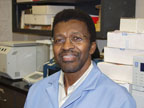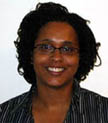Prairie View A&M University 2006
From 2006.igem.org
Contents |
Students
Advisors
Dr Raul Cuero,(PhD)
Dr. Raul Cuero, (PhD), Microbiologist, Distinguished Professor.Research Leader, Scientist and Contact Person for Prairie View A&M University iGEM 2006 group. Dr Cuero holds 8 scientific inventions and more than 90 scientific publications.Dr Cuero is currently working on fungal toxins at the molecular level, and on biogenesis. He is also the author of the book "Triumph and Survival".
Email: olimpa@aol.com
www.raulcuerobiotech.com
[[Dr Harriet Howard-Lee Block]]
Professor. Area of Interest:Molecular Biology Department Head of Biology
[[Dr Dierdre Vaden]]
Dr Vaden's is a Genetics professor and her work is mainly in yeast genetics and phospholipids metabolism.
[[Dr Huajan Fan]]
Assistant Professor in Chemistry.
Project
(We have changed the title of our project so many times)
Tri-Metallic Biosensor- PVAMU [[1]]
Background
There exists two essential needs which enabled us to design the trimetallic probe. The need for alternative forms of oil, in fact their methods and the bioremediation of metals ions from the environment.
Micrococcus luteus strain (ATCC 4698) was transformed by plasmid pUC57-S-3M, in which Fe (II), Ni (II) and V (II) were fused to the fluorescence proteins (ECFP, EYFP, and mRFP respectively and to a fluorescent protein coding region [C0061(lux I)] ligated with a signaling sequence BBa_I13207.
Favorite Biobrick Map(Upcoming)
The pUC57-S-3M was standardized for its specific sensoribility response to three metal ions and to sulfur (S), in order to detect metal contamination and/or hydrocarbons associated to these metals. Single and combination of the tree metals were used at different concentrations (0.2, 2, 50 ppm). The pUC57-S-3M was grown in the presence and absence of oxygen and/or hydrocarbon (Thiophenol). Only results from combined metals are reported. The biosensoribility was determined by the response of the pUC57-S-3M to the different concentrations of the metals. This response was measured by bioluminescence, fluorescence, DNA concentration, bacterial growth. These parameters were related to sensoribility of the pUC57-S-3M.
Parts used
/
/
/
/
/
/
/
/
Favorite Parts/Modified Parts/ Parts By Prairie View
Project Planning Diary
Calender
May
-Brainstorming and recruiting.
June No entry
July
'August ' -We have been able to isolate a few colonies of transformants of E.coli containing the plasmid 19H (pSB1A2 or BBa I13543). We have been bent on picking up sequences containig lux genes.
September
-So far we have tried to isolate several plasmids but results have not been good. So far we have successfully amplified and isolated 4 plasmids. Well no one will believe how much we got done in such a small amout of time. [Laina's Diary]
October Determined that we will base our sensor on the concentrations of three metals ions, Vanadium, Iron and Nickel,and including elemental sulfur. Our focus is on the DNA expression, determined by luminesence and flourescence.
Student Profiles
Laina | Leslie | Christian | George | Oludayo | Jessica | Terry|Fredrick | Victor
Face File [[2]]
References
^ Lovley, DR (2003). "Cleaning up with genomics: applying molecular biology to bioremediation". NATURE REVIEWS. MICROBIOLOGY. 1 (1): 35–44. PMID 15040178.




